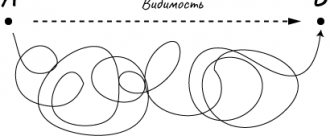Whether we like it or not, we all get caught up in negative thoughts from time to time. An inner voice suddenly begins to tell us that we are not smart enough, successful enough, or should become such and such...
Trying to escape from or deny these thoughts takes up too much energy. You can wage a mental war with them ad infinitum, but in the end they will return, becoming even more unpleasant and intrusive.
Psychotherapist and former Buddhist monk Donald Altman has written several best-selling books that help use Eastern mindfulness practices to address the most common problems we Westerners face.
Specifically, he suggests using the strategy of "good old fashioned jiu-jitsu" and turning negative thoughts on their head with a simple action. This mental exercise can be called in one word - gratitude.
“If this word makes you sleepy, let me share some research that might surprise you,” Altman writes.
This study found that regular gratitude practice is highly effective and leads to the following results:
- the level of life satisfaction increases,
- there is progress in achieving personal goals,
- Stress levels decrease, depressed mood becomes less pronounced,
- young people increase their attentiveness, enthusiasm, persistence and ability to concentrate,
- it becomes easier to maintain social contacts, the willingness to provide help and support to others increases,
- the focus of attention and measurement of success shifts from material to spiritual values, the level of envy of others decreases,
- a good mood lasts longer, a feeling of connection with other people arises, the outlook on life becomes more optimistic,
- in patients with neuromuscular diseases, the quality and duration of sleep improves.
What is "overthinking"
According to neuropsychologist Dr. Katie Davis, people who are prone to introspection are unable to regulate and shift their attention away from a specific thought or subject of their concern. They are easily distracted during the day and often cannot concentrate on work.
One little thing can unsettle such a person; he is unable to do anything until he solves his problem or stops thinking about it.
A few words about chronic insomnia
Before we continue, it is necessary to make a small but extremely important digression for the 10% of people who suffer from chronic insomnia. Namely:
- cannot sleep or wake up frequently almost every night;
- this continues for more than a month;
- this interferes with normal life and leads to nervous breakdowns.
If this sounds like you, try the techniques below, but keep in mind: they won't help you cope with severe sleep disorders. Most likely, you have unsuccessfully tried to overcome insomnia more than once: you followed the rules of sleep hygiene, meditated, used lavender oil, etc. Just in case, don’t really hope that these tips will become a panacea.
It’s better to ask your doctor to refer you to a specialized specialist who treats insomnia with proven methods. Everyone else - that is, those who have sleep problems only occasionally - can safely apply these techniques today.
Switch to sensory observations
The goal is to slow down this stream of consciousness and allow the brain to actually process the thoughts that arise in it, rather than replay them endlessly.
One strategy that's fairly easy to practice and incorporate into your daily life is to take five minutes and make a mental note of all your sensory observations, suggests Dr. Davis. – Try to block out extraneous thoughts and focus on the sounds around you.
This is especially useful when you can't sleep. Instead of thinking about all the things you have to do or have already done, focus on the sound of the fan or cars passing by. “White noise” works on this principle. Download a special application with the sound of sea waves or forests and fall asleep to it. This will help you disconnect from thoughts and extraneous noise.
Sensory observations can also be useful during the day, notes the neuropsychologist. This is a concrete and effective way to shift your thinking during times of stress. You can focus on something else to calm yourself down.
1
Read on topic: 12 thoughts that make you feel unhappy
Insomnia is a modern “trend”
If this sounds familiar to you, know that you are not alone. Insomnia attacks regularly occur in 30% of adults, and their number increases every year. Even if you're one of those lucky people who usually falls asleep easily and quickly, you've probably had nights when you tossed and turned, trying in vain to turn off your annoying brain. But he kept mumbling about business, worries, debts, ideas and plans, replaying awkward moments, humming obsessive songs and didn’t want to stop talking, even if he banged his head against the wall.
Admit that you can't control everything
Another important aspect of obsessing, according to psychologist and author Paul Coleman, is what underlies the process. He believes that behind overthinking lies a desire to control everything. Repeatedly repeating the same thoughts in your head is a destructive way to reduce uncertainty and try to prevent potential threats. Constantly thinking about “what ifs” does not help you anticipate all the consequences, but only adds stress and causes indecisiveness. According to Coleman, obsessing leads to what is called "decision fatigue":
An overthinker might spend all day thinking about a problem, overthinking it, and then be unable to make a decision about what to order at a diner.
You need to let go of your need for control and accept the fact that you cannot control every factor and outcome in life. Practically, you have to tell yourself: “I accept uncertainty, even if I don’t like it.”
Stay here and now
We are used to spending a lot of time waiting - surfing the Internet, watching sports programs, entertaining TV shows, and so on. Gratitude literally catapults us into the present moment because it requires active engagement. We just have to be in the present moment in order to feel what we can say thank you for.
This gives us a feeling of a stronger connection with reality and an optimistic view of the outcome of our actions. Gratitude helps us build resilience because we focus on the positive.
No. 5. Materialize thoughts into objects
Even in moments such as a quarrel or an exam, it is sometimes necessary to abandon our thoughts while we listen to our interlocutor or teacher, so as not to blurt out something rude or unnecessary. To do this, simply imagine pushing away thoughts with your palms. At the same moment, materialize thoughts in your head, because they can turn into a stone, a tulip, a boiling kettle, an angry face, a cat, and so on. Imagine it and gently push it away. Again and again. This is an effective remedy for those whose speech runs ahead of their thoughts.
Giving up thoughts does not mean giving up knowledge. Most of the things we think about in our heads have nothing to do with the biography of Amadeus Mozart or the theory of Stephen Hawking, right? Our head is most often busy with worries about tomorrow, plans, formulations and annoyance at something. Meditation clears away these things and helps you live in the present moment, using those same knowledge and skills more effectively.
«»
Tags: meditation calm harmony mind healthy mind tips useful tips self-improvement
Interaction with fire.
The practice of interacting with fire is similar to speaking. Fire becomes the only interlocutor-listener. How to proceed here, step by step instructions:
- Create conditions so that no one will distract you.
- Light a candle/fireplace/bonfire.
- Position yourself opposite so that it is comfortable for you to contemplate.
- Mentally turn to the fire. Greet the elements.
- Share your intentions for this interaction.
- Tell him everything you think about, what worries you.
- When you have shared everything you wanted, continue to simply contemplate.
- When you feel complete, thank them for the interaction.
When you do step 5, you can declare a desire to find inner peace or a desire to get an answer to a worrying question. The effect will not appear from the first approach. Just keep going. Every approach and every interaction is a setup for a deeper next contact. You can feel tangible results after 4 weeks of daily practice.
- Performing as a team: creates a supportive atmosphere.
- With the host: helps you get in the mood.
- Duration: from 20 minutes.
Body meditations.
If you do monotonous simple things that do not require intellectual thought, then you can enter a state of trance. During the process itself, it is important to return attention to bodily sensations. If possible, you can even periodically close your eyes so that the focus on internal bodily sensations is increased. Attention to the body. Are thoughts coming? Don't chase them, don't run away from them. Accept their existence, let them pass on, just as you let clouds float above your head. If you feel that you have focused on your thoughts, return your attention to the body again. How does it move? What do you feel? How comfortable is the movement? How to make it more comfortable? How to flow through your movements in space?
The simplest example: walk along a sandy beach/earth/grass/snow and direct all your attention to the sensations in the body, the sensations in the feet, the breath, the sensations of the body as a whole. Attention can be transferred from one part of the body to another, then cover the body completely.
- Execution in a team: the common field strengthens if you do not distract each other.
- With the leader: the presence of a person nearby in a deep process allows you to quickly immerse yourself.
- Duration: from 10 minutes.
How to get rid of negative thoughts: 5 effective techniques
5 Cognitive Behavioral Tips for Overcoming Obsessive Thoughts
Method 1: Write down your thoughts
Psychologists believe that it is important to keep a record of your thoughts. This allows us to apply logic to the mental processes in our heads.
Let's give an example: Someone is afraid of losing his job. Overnight, he becomes obsessed with the fact that management thinks he is doing everything wrong and his anxiety grows. This vicious circle in the head will eventually lead to a self-fulfilling prophecy. That is, by constantly thinking about everything that he could do wrong, sooner or later this person will do everything wrong. To gain control, balance and consistency in your thoughts and actions, nothing is more helpful than writing down your negative thoughts.
All you need to do is take a piece of paper and write down every negative idea that appears in your head. And then find out for yourself its truth. Statement: “I just know that everything I did at work was wrong.”
Truth Revealing: Is there anything that proves it's true? Has my boss expressed dissatisfaction with my work? What did I do differently today? What seems so bad to me?” Mentally, it is more difficult to sort through fears and apply an analytical approach to them, but on paper, all the contradictions and doubts immediately become noticeable.
On the Helppoint portal it is possible to keep an online diary. You can not only record and analyze your thoughts and beliefs, but also receive an analysis of your situations by a psychologist. How it works? Register, complete the questionnaire and the algorithm will select the most suitable psychologist for you. Pay for the Diary consultation type, and start writing in the chat as in a diary as much and whenever you want. And your psychologist will regularly come into this chat and analyze what you have written, give feedback, advice, and exercises.
Method 2: Affirmative Action Planning
This is good advice. Plan healthy activities at the beginning of the day. Something as simple as “quality time for yourself” gives very positive results in dealing with obsessive thoughts and allowing you to get rid of nervousness. It stops you from overthinking. These actions can be as simple and short as going out for coffee with a friend. Give yourself a break. Buy a book, cook a nice lunch, listen to music, etc.
Method 3: Hierarchy of Problems
Intrusive thoughts are like smoke from a chimney; they are an indication that something is burning inside us. This inner fire consists of our unresolved problems, which are difficult to get rid of, and which only get worse over time. The first step to controlling the focus of our thoughts, feelings and suffering is to clarify them.
How can we do this? There is advice that will help with this: list your problems from the simplest and least burdensome to the complex ones that can be solved with a lot of effort. Start by writing everything down in order. You visualize and organize all the chaos that is inside you using brainstorming. Then make a hierarchy, starting with those that you consider small problems, and ending with the most paralyzing ones, which seem too big and insoluble to you.
Once you have a visual order, reflect on each point on the scale. Try to think rationally and come up with solutions for each problem.
Method 4: Separating Emotions from Reality
Emotional reasoning is a very common type of bias. For example, if I've had a bad day and I feel frustrated, I start to see life as an endless, dark tunnel. Another common idea is to think that if someone doesn't love me, it's because I don't deserve love. It can be difficult to get rid of stereotypes.
Thus, another healing technique that we must learn to use daily is objectivity. We cannot forget that our emotions do not always point to objective truth. These are just momentary moods that we must understand and manage.
“If our thinking gets bogged down in distorted symbolic meanings, illogical reasoning and erroneous interpretations, we become effectively deaf and blind.”
Aaron Beck
Method 5: Preventing Intrusive Thoughts
Whether we like it or not, there are and will always be situations that will force us to plunge back into the abyss of obsessive thoughts. One way to notice these situations in time is to keep a diary. Something as simple as writing down your feelings every day makes you more conscious.
Write down everything that comes to your mind. Describe situations when you experienced certain feelings. There may be people, habits, or scenarios that make you feel out of control or vulnerable, and that keep you from letting go of your fears.
By keeping a record of our days, we will see what those situations are that cause negative feelings. With this technique, we can prevent a negative reaction to them (and this will help us cope with obsessive thoughts). In conclusion, there are many cognitive behavioral techniques that can help with these and many other situations where we need to cope with anxiety, stress and depression. There are also good books on the topic, including Aaron Beck's Cognitive Therapy for Anxiety Disorders: Science and Practice.
The influence of bad thoughts on our lives
The University of Rhode Island conducted a study on negative ideas that was published in the journal Psychology and Aging. This particular study was dedicated to finding out how thoughts affect people from different age groups. The results showed that age does not matter when it comes to negative thinking. At any age, a person can fall into the trap of obsessive thoughts, and at any age this leads to negative consequences and even mental illness. Therefore, it is worth fighting this phenomenon and trying to remove the constant internal destructive dialogue in your head.
Negative emotions will make you feel disappointed in yourself or generally bad. If you don't control this negative way of thinking, you open the door to depression and anxiety.
Intrusive thoughts affect overall functioning. When they first settle in our minds, we begin to experience discomfort, followed by attempts to get rid of unwanted visions in our heads. But the more we try NOT to think, the more thoughts take possession of us - it’s like a swamp of thoughts, the more you flounder, the deeper you sink. Surely you know this famous trick: “Don’t think about the blue-eyed polar bear for the next five minutes,” and your next thought will be exactly what you were asked not to think about.
Ultimately, this leads to chronic stress and serious health problems, both mental and physical.
Completion or continuation.
Thank you for attention. All of the above is just a subjective opinion based on numerous observations and personal experience.
Ivan Patskevich. This is my purpose in human design: to explore and tell.
In the hidden part of the post you will find:
- How to be calm like a tank.
- How to communicate with the Universe.
- 4 more practices on how you can stop the flow of thoughts.
- A method that allows x2 to enhance the effects.
To open the cache, share the link to the article on any social network.
##
4 more practices to stop thoughts:
- Silence. Tank calm.
- Fire.
- Meditation.
- The Universe is speaking to you.
Summarizing topics:
- X2 strengthening of any practice.
- Why stop thoughts? What's next.
Pepper ceremony.
Completely similar to standing on nails, only the pain here is experienced through the taste buds, through the mouth :). The brain will also fuss, for it a burning sensation in the mouth is an indicator of the approach of death. The death of the body, a little more and we will die. Therefore, a hurricane of thoughts arises in my head. Accept it, let it pass, try to relax. It helps. If, on the contrary, you begin to resist, then the process will be more unpleasant.
There is no physical danger to the oral cavity or intestines. The body can withstand much more load. But there are benefits in the form of a shake-up for the taste buds and digestive system. Shake-reboot. Just as a short dip in an ice hole is beneficial for the body, so the fiery pepper practice is beneficial for the inner space.
After picking the peppers with your hands, do not touch them in the eyes. If you poke it in the eye, it will burn. There is nothing scary about this. You will experience the process through your eyes. Nothing can stop the burning. Accept it, let it pass, try to relax.
The first time it is better to participate with a pepper master. Ask him to explain to you: what to expect, what to do, how to eat the pepper itself, what not to do. Peppers with a high level of spiciness are suitable for the ceremony; any peppers will not be suitable. When you understand how it works, then you can practice it yourself. Treat your friends ;).
As the burning goes away, calmness sets in, the internal dialogue subsides, and a feeling of presence takes over. Whether it’s worth moving to heaven through hell is up to you to decide :). Think, try. If you have already experienced this, then share your feelings in the comments on the page below. The Pepper Ceremony is the practice of moving through pain.
- Execution in a team: fun to watch the participants :).
- With a leader: the first time is definitely with a master.
- Duration: from 30 minutes.
- Full instructions for participation/conduct. You can buy it on VKontakte.











